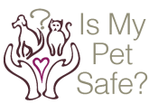Lost Pet Recovery by Microchip
Last week a friend's wife asked me about microchips and pets. Specifically, she wanted to know what happens if the pet parent moves, how would they find them? It is an interesting question and in verifying my answer, I learned a lot more about microchips and lost pets.

Implantable RFID devices (microchips) have been available since at least 1985. These tiny devices (think long grain rice) are a safe and mostly effective way to identify pets. The chip is encapsulated in a glass container designed to minimize biological interactions and to stay put in one standard location (around the shoulder blades). Microchips are inactive transponders and only produce a signal when a special scanner is passed over them.
Virtually all vets and many rescue operations can microchip your dog or cat (and probably any other animal). The chips are sold in bulk and cost about $5 or so each. Unfortunately, microchips are not quite standardized within the US. Initially, all US microchips operated on the 125 kHz frequency. A number of companies still make products on that frequency (AVID, HomeAgain, 24PetWatch). However, there has been a shift to make the entire world operate on the same frequency (134.2 kHz) and many of the major players produce those kind of microchips (24PetWatch, 911 Pet Chip, AKC, Bayer, Datamars, Found Animals, HomeAgain and ResQ). Before chipping your pet you should make sure you know what devices are available from your vet and what frequency they operate on.
So how does a microchip help your lost pet get home to you? Generally speaking, a recovered pet is brought to a vet or shelter where a device is used to scan for a microchip. If one is found, the identification information (just a long number) is used to search online registries (databases) for owner information. I'll expand on that facet in a moment.
The critical thing to know is this: pet parents must provide accurate contact information when the microchip is registered and this data must be kept up to date! That includes e-mail, cell and home phone numbers and similar information for an alternate contact (such as a friend or relative). Without this contact data, the microchip is far less useful. In some cases it may be possible to track the chip back to the vet who implanted it. But if your contact information has changed, there is a good chance the original vet will not know how to contact you either. (Less critical but important: microchips do not confer ownership - this is because anyone can implant a chip.)
Taking a step back, your pet will either be chipped at a shelter/rescue or by your vet. In the latter case, different chips come with differing registration options. Some will, as part of the cost, include a 'lifetime' registration. Others may be less costly and offer no registration features. A pet that gets a microchip at a shelter or rescue operation will be registered in the name of that operation.
But where and what are these registries? Many of the manufacturers have their own database systems and for a fee, allow pet parents to register their pet's microchip number. Most will also register competing brands of microchips. As an example, Avid is associated with PETtrac Pet Recovery Network. For $19.95, a pet can be registered for life.
HomeAgain is a subsidiary of Merck & Co. The HomeAgain service is $17.99 and requires annual renewal to keep active all of its features such as lost pet alerts to volunteers (similar to Amber alerts), emergency vet hotline and help covering the cost of transporting a lost pet back home. However, even if you subsequently drop the annual service renewal, your pet's information will remain in the HomeAgain database. Petlink is associated with Datamars and is very similar to PETtrac.
The Found Animals registry is a not-for-profit organization that provides lifetime registration at no cost, including lost pet alerts to shelters and rescue organizations.
So what happens when your pet is lost? Normally the shelter or vet your pet is brought to will use a scanner to try to read data from a microchip, if present. Unfortunately, not all scanners are "universal" or as universal as claimed. Recall earlier that the microchip transponder typically operates on one of two frequencies (there is a third but it for AKC chips only). For a scanner to be universal, it must be able to pick up all of those frequencies. Some scanners may instead be advertised as picking up multiple brands of microchips but only on one frequency.
This creates a less than ideal situation as the person using the scanner may not realize a negative response may be reflective of the limits of the scanner and not the absence of a microchip. This is why the industry urgently needs to standardize around the ISO worldwide frequency at 134.2 kHz.
Once a chip is read, a registry must be consulted, often beginning with the one associated with the chip manufacturer. With microchip ID in hand, the registry is contacted so they can alert the registered pet parent with the contact information previously provided (note: the registry does not give out personal information, they are the ones who will contact the pet parent).
If there is no response, it is up to the shelter or vet to keep trying other registries. This is both a time consuming process both on the front end (contacting the registry) and back end (waiting for a pet parent to respond). In the past this could lead to a situation where a pet's chip was registered and kept up to date with a service that is never contacted.
To avoid such a disaster, the industry has taken steps in the right direction by providing registration data to a common database maintained by the not-for-profit American Animal Hospital Association. This allows a vet, shelter or rescue to go to one location to get registry information. AAHA presents this information in order of most recent update . In theory, the organization doing the lookup may only need to contact one registration service to reach the pet's owner. At this time, the following companies share information with AAHA:
24PetWatch Pet Protection Services
911PetChip
AKC Reunite
BC Pet Registry
EIDAP
Found Animals
Free Pet Chip Registry
HomeAgain
Homeward Bound Pet
InfoPET
Microchip I.D. Solutions
Microchip ID Systems, Inc.
Nanochip ID Inc.
National Animal Identification Center
PetKey
PetLink
Petstablished
Save This Life
SmartTag Microchip
AAHA is providing a valuable service to pet parents. However, for how long it will continue to do so is unknown (though AAHA has been around for many, many years). For that reason, I would advise pet parents to register their pet's microchip both with the service associated with the chip manufacturer as well as at least one other registry, It may also be prudent to provide different backup contacts with each registration to maximize the chances of a positive identification being made quickly. Pet parents should also periodically verify that their registration is accurate, remains active (errors and omissions do happen) and is visible to the AAHA database.
Finally, pet parents need to realize that the way most lost pets get home is from an ID tag on a collar. Tags require no scanner, are 'universal', should be easy to read and are the quickest way home. Make sure ID tag information is kept current and legible.


